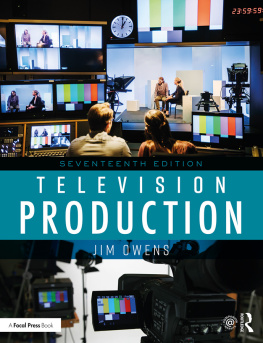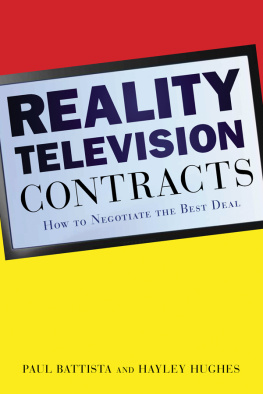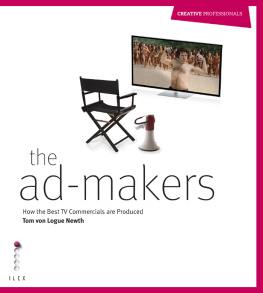Gain the skills you need to succeed in the television industry and master the production process, from shooting and producing, to editing and distribution. This new and updated 17th edition of Television Production offers a thorough and practical guide to professional TV production techniques. Learn how to anticipate and quickly overcome commonly encountered problems in television production as author Jim Owens details each role and process, including the secrets of top-grade camerawork, persuasive lighting techniques, and effective sound treatment, as well as the subtle processes of scenic design, directing, and the art of video editing.
Updated throughout, containing a range of new figures and diagrams, the 17th edition of this classic text includes:
Television Production
17th Edition
Jim Owens
Asbury University

Seventeenth edition published 2020
by Routledge
52 Vanderbilt Avenue, New York, NY 10017
and by Routledge
2 Park Square, Milton Park, Abingdon, Oxon, OX14 4RN
Routledge is an imprint of the Taylor & Francis Group, an informa business
2020 Taylor & Francis, The right of Russell Schwartz and Katherine MacDonald to be identified as authors of this work has been asserted by them in accordance with sections 77 and 78 of the Copyright, Designs and Patents Act 1988.,
The right of Jim Owens to be identified as author of this work has been asserted by him in accordance with sections 77 and 78 of the Copyright, Designs and Patents Act 1988.
All rights reserved. No part of this book may be reprinted or reproduced or utilised in any form or by any electronic, mechanical, or other means, now known or hereafter invented, including photocopying and recording, or in any information storage or retrieval system, without permission in writing from the publishers.
Trademark notice : Product or corporate names may be trademarks or registered trademarks, and are used only for identification and explanation without intent to infringe.
First edition published by Focal Press 1963
Sixteenth edition published by Focal Press 2016
Library of Congress Cataloging-in-Publication Data
Names: Owens, Jim, 1957 author.
Title: Television production / Jim Owens.
Description: 17th edition. | New York : Routledge, 2020. | Includes index.
Identifiers: LCCN 2019016495 | ISBN 9780367136321 (hardback) |
ISBN 9780367136338 (pbk.) | ISBN 9780429027581 (e-book)
Subjects: LCSH: TelevisionProduction and direction.
Classification: LCC PN1992.75 .M5 2020 | DDC 791.4502/32dc23
LC record available at https://lccn.loc.gov/2019016495
ISBN: 978-0-367-13632-1 (hbk)
ISBN: 978-0-367-13633-8 (pbk)
ISBN: 978-0-429-02758-1 (ebk)
Typeset in Gill Sans and Avenir
by Apex CoVantage, LLC
Visit the companion website: www.routledge.com/cw/owens
Dedicated to my wife, Lynn, and my daughter, Sarah
Contents
I believe that good television can make our world a better place.
Christiane Amanpour, CNN Reporter
Any program, at any time, on any device, at any location.
Frank Beacham, Director and Producer
Terms
DVE : Digital video effect equipment, working with the switcher, is used to create special effects between video images. A DVE could also refer to the actual effect.
DSLR : A still camera (digital single lens reflex camera) that shoots video, allowing the photographer to see the image through the lens that will capture the image.
Linear editing : The copying, or dubbing, of segments from the master recording (traditionally tape) to another recorder in sequential order.
Nonlinear editing : The process in which the recorded video is transferred onto a computer. Then the footage can be arranged and rearranged, special effects and graphics can be added, and the audio can be adjusted using editing software.
Prosumer equipment : Prosumer equipment, sometimes known as industrial equipment , is a little heavier-duty and sometimes employs a few professional features (such as interchangeable lenses on a camera), but may still have many of the automatic features that are included on the consumer equipment.
Second screen : Todays television audience is not just watching television; they are also on a computer of some type, often called the second screen.
Smartphones : Smartphones have become the video camera of choice for amateurs. As the image quality has grown, smartphones have been adopted by news stations, documentary producers, and other professionals as a backup camera.
Switcher (vision mixer) : Used to switch between video inputs (cameras, graphics, video players, etc.).
The definition of television is changing. When you put video on any device, it becomes a television. Its because of the programming, its the quality, its the story line. Its all those things we associate with television programming. Television was never the boxit was the programming that was on the box.
Chris Pizzuro, Head of Business Development, Canoe Ventures and former Vice President, Digital News Media, Turner Entertainment
The 2018 Emmy Awards were a perfect example of televisions transition to the Internet. Online Netflix (online) and HBO (on-cable and online) each won 23 Emmys. NBC led the broadcast networks by winning five Emmy Awards.
Defining television can be quite difficult. It used to be easy; television directors and producers knew that their final program would be generally viewed on a 19-inch television set located in a home. As you know, that is no longer the case. Televisions definition now also embraces technologies such as large-screen televisions, computers, the Internet, tablets, and smartphones. These changes have brought many new players into the television industry. Online networks now create programming that is as high quality as what we have seen in the past on the broadcast networks and cable. With their lower cost overhead and monthly subscription income, they increasingly have the money and audience to pull in some of the best program creators.














